1979 Dutch Grand Prix race report
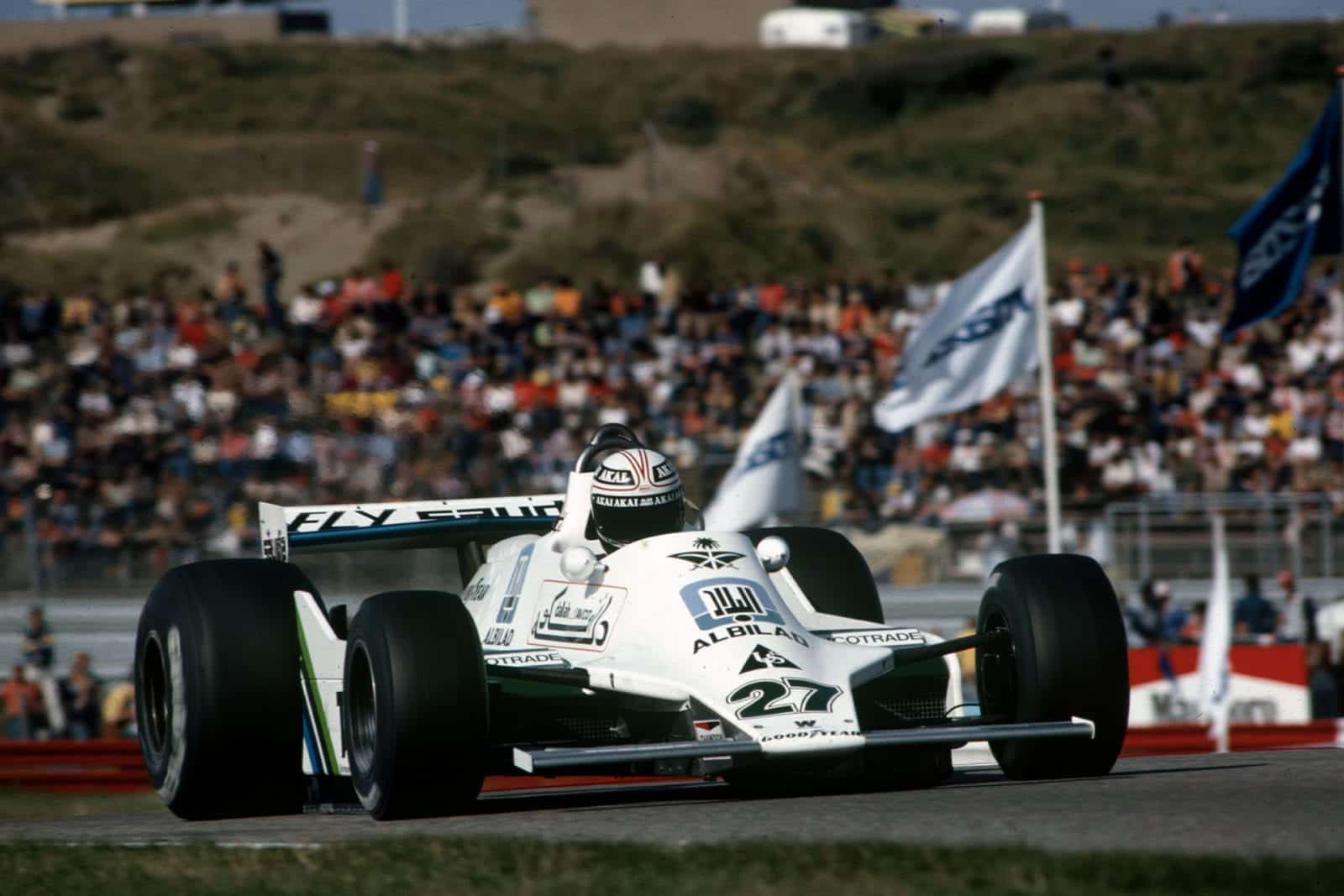
Jones took his third win in a row for Williams
Motorsport Images
And another for Williams
Zandvoort, August 26th
Arrival at Zandvoort was greeted with thunder and lightning, rain and floods, and it was difficult to tell the difference between the North Sea and the sky, or the beaches or the circuit. Fortunately the awful weather eased on Friday morning when testing was due to start, though there was still a lot of water about. Since last year the driver’s Safety Committee, which seems to consist of Lauda, Scheckter, Laffite (when he’s not busy doing other things) and Andretti (when the others remember to tell him), decided that the back part of the Zandvoort circuit was becoming too dangerous because of the higher cornering speeds being achieved now and they demanded (yes, demanded, not asked) that a “chicane” should be put in to slow things down a bit. Unfortunately the whole affair got muddled earlier in the season, for Lauda and Scheckter threatened a boycott if the work was not done and Andretti said “no way, boycotts are out”. At one of the meetings Laffite was busy practising his BMW M1 for the Pro-Car races! The result was that a “chicane” was built of the wrong shape and in the wrong place, and nobody took responsibility. Instead of a second-gear “chicane” the Dutch built a slight wiggle into a top-gear right-hand bend, which merely caused drivers to lift off, drop down a gear, and take the wiggle flat-out. The difference to the lap time was unnoticeable and the safety factor was negligible. Sometimes it is better to leave things alone.
Qualifying
With the damp conditions on Friday morning there was not too much enthusiasm for dashing around the circuit, some teams not even bothering to send their drivers out at all. Jean-Pierre Jarier was back in the Tyrrell team, Lotus arrived with three Type 79 cars after a lot of private testing with a revised Lotus 80, which didn’t inspire much confidence; the Brabham team had an air of unreality about it with Lauda just waiting to leave, and a Cosworth-powered BT49 having been out on test, bidding farewell to the Alfa Romeo engines, and Shadow had built new front suspensions on their cars, with a wider track. Ferrari, Renault and Williams had their eyes on the more important things, like beating each other and winning the Dutch GP and the Ligier team were far from settled, though lckx was still replacing the injured Depailler. Hector Rebaque’s private team had a brand new car in the paddock, but not yet for running. This was in effect a new and improved Lotus 79, which they had built themselves with the assistance of the Penske racing shop in Poole, and formed an interim step before branching out on an entirely new car. This interim car used a lot of Lotus 79 running gear components, but had an improved monocoque and different air-flow characteristics underneath designed by Geoff Ferris of the Penske Organisation.
Apart from those drivers who found their way through the new “chicane” the morning was uneventful and inconclusive, but with the track drying rapidly everyone got wound up ready for the afternoon qualifying session, though another downpour of rain during the lunch-break slowed things up. It was still very wet and raining when the timed practice began at 12.30 and Alan Jones was out in the spare Williams (FW07/1). The Team Lotus drivers’ modified Type 79 cars had the normal Hewland gearbox in place of the Lotus/Hewland they had used in Austria, and the rear suspension was virtually back to 1978 specification but the rear brakes were mounted “outboard”. In place of the covered in tail and rear aerofoil mounted on side-plates, the cars had uncovered rear ends and aerofoils mounted on a central pillar like a Williams! Andretti had 79/2 and Reutemann 79/4, while the spare car (79/5) was to normal pattern with inboard rear brakes and the rear aerofoil mounted on side-plates. The spare Brabham-Alfa (BT48/02) had totally new gearbox internals, so during the afternoon Piquet took it out for some bedding-down, and in the meantime his own car (BT48/03) had its springs changed.
It was not long before the rain stopped and the sun came out so that by the end of the hour and a half conditions were pretty good for those who were ready for them. As is becoming consistent the pace was being set by the Williams drivers, the Renault drivers and Villeneuve with the Ferrari, and this first afternoon was no exception. Jabouille had been trying both his cars, RS11 and RS10, having different rear axle ratios in them, and he decided that RS10 had the better ratio for the conditions. With little fuss he had taken the pole-position, while Jones and Villeneuve were vying for the other place on the front two, but then word went round that Regazzoni was getting a bit serious, and sure enough the swarthy Swiss was up with them and by the end of the afternoon he was in front. His time of 1 min 16.316 sec. just beating Jabouille’s 1 min 16.338 sec., Jones and Villeneuve being half a second behind. There was a time when half a second covered a handful of cars but these days some of the good runners are lucky to be two seconds behind the leaders. Already the front-runners were faster than the pole-position time of last year, and the “safety-chicane” was supposed to have slowed things down a bit!
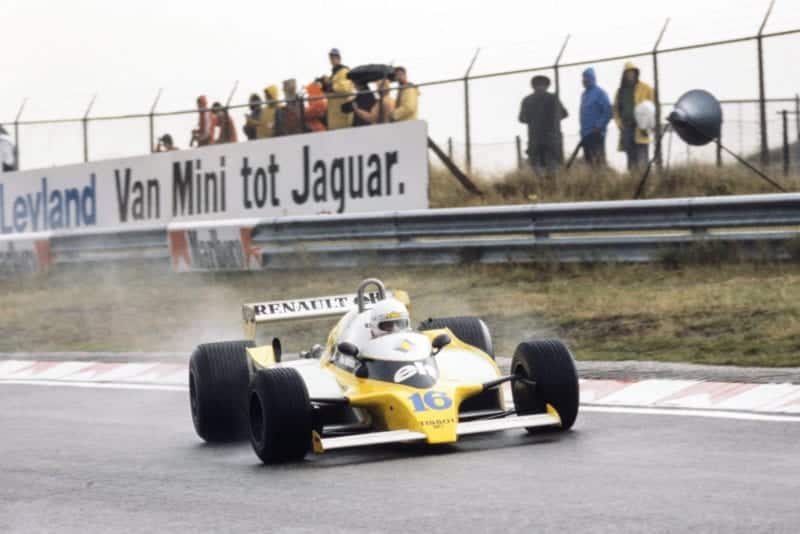
Renault’s Rene Arnoux took a second consecutive pole
Motorsport Images
After a lot more rain in the night, Saturday began bright and sunny and things cheered up enormously, though there was still gloom in the Lotus pit, not much joy in the Brabham pit, an air of confusion in the McLaren pit, and hopefulness among the lesser lights. Jones was still in the spare Williams, though Jabouille was back in RS11, Regazzoni was still driving hard and Pironi had a Williams-type centre-pillar rear aerofoil on his Tyrrell 009/6, which also had revised rear suspension with fashionable “outboard” brakes. Rosberg was concentrating on Wolf WR9, which also had the fashionable Williams-type rear aerofoil, but Ferrari and Renault were not copying anyone. As the day went on the weather got better and by the time of the timed session everything was about perfect. Jones was in FW07/4 for the afternoon, Regazzoni was in FW07/2 as always, and they had fourteen sets of qualifying tyres ready to be used up, with more to come if required. Practice had not been going long before Andretti was forced to take the spare Lotus as his own had the left-hand exhaust tail pipe come adrift, and Jabouille switched to the spare Renault as he was still undecided about gear ratios.
Now it was Jones and Arnoux who were setting the pace, both getting away into a class of their own with laps at under 1 min. 16 sec., while a lot of drivers were still struggling to get under 1 min. 19 sec. It was Arnoux who got the final word with a lap in 1 min. 15.461 sec., but Jones was not far behind, with 1 min. 15.646 sec., and then came his team-mate Regazzoni with 1 min 16.228 sec. and after that times were a bit academic. Scheckter got stuck in and beat his young team-mate, as did Lauda by beating Piquet, while Lafitte tried Ickx’s car, leaving the Belgian to kick his heels behind the pits. Surprise of the afternoon was Rosberg with the Wolf WR9 for he got himself well under control and finished up just behind Laffite, the first of the non-super starts, but even so he was nearly two seconds slower than Arnoux, and if the same pace was kept up in the race it would mean him being lapped before the end. After a lot of misfiring trouble on both McLarens, even on the brand new one that John Watson was driving, the team got themselves sorted out to finish up in the middle of the grid. The Lotus scene was abysmal, with the reigning World Champion down among the tail-enders. Nothing they seemed to do made the car feel right, or if it did, it was slow.
With still some time to go before the end of the timed session the air suddenly got distinctly cooler and within minutes rain was pelting down again so the final practice just fizzled out, everyone except Renault and Williams feeling pretty depressed about the whole business.
The regulation BMW-M1 race took place after practice, though another shower of rain soon put a stop to it. Another burst of sunshine and a dry track allowed the BMW people to restart their race, but meanwhile the Formula One cars were being prepared for the 75 laps race to follow on Sunday afternoon. New engines were installed, gearboxes inspected, clutches replaced, brakes and suspensions checked over and so on. The amount of work that is done in the paddock after practice never ceases to amaze. There was an unusual situation in store, for in Holland you are not allowed to make an unseemly noise before 1 p.m. on a Sunday, and a racing engine is considered unseemly. With the race due to start at 3 p.m. it meant that the half-hour warm-up period normally held on Sunday morning, was to be uncomfortably close to the start of the race, allowing no time for any serious work.
Saturday night was another one of torrential rain and the campers and those having to work through the night must have become really fed-up by this time, but Sunday morning started by looking promising, though everything was still damp as midday approached. At 1 p.m. a maroon was fired up into the air to let everyone know they could now make a noise, and the thirty-minutes of test running began. Piquet was in the spare Brabham (BT48/02), as his own had developed a small weep from its oil tank, but all the others were in their number one cars, though all the spare cars were standing by. The spare Ferrari had an old-type exhaust system with two tail pipes above the rear axle assembly, and two below, but it had a new body-top with the area over the side-pods ending in vast open-topped “chimneys” to help exit the air under the pods. Although it was prepared for Villeneuve on Saturday afternoon, it was never run. Pironi still had the central-pillar-mounted rear aerofoil on his Tyrrell, and both Brabhams were running with nose-fins. Alan Jones had a new engine in FW07/4 and though it was going all right, the team were not happy as the engine was breathing too many fumes from its atmospheric breather. Jabouille had dickered about between his two Renaults, but finally chosen RS11, and Arnoux was all set to go. During the hour before the pit-road opened again to let the cars go round to the start, the Williams team decided that Jones should use the spare car, just in case there was trouble brewing inside the engine in FW07/4. Tyres, springs and shock-absorbers were all swapped over to FW07/1, everything else on the car being ready to race. Laffite suddenly decided he did not like the car he had been using all through practice and demanded to use the spare car. As this had never been run at all it seemed a strange thing to do at this late hour.
Race
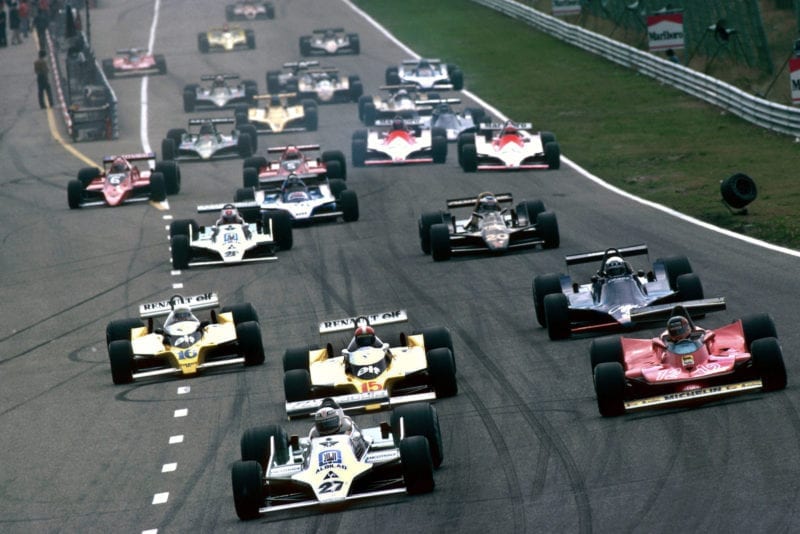
Jones leads at the race start
Motorsport Images
At 2.30 p.m. the first cars left the pits and went round the circuit to the start area, to line up on the dummy-grid. Reutemann, Jones and Regazzoni all dived into the pit lane, went through the pits and round for another lap. Andretti arrived at the start line minus the skirts on his Lotus 79 and we all thought Chapman was about to start a new aerodynamic trend, but not so, they were still fiddling about with them on the pit counter and he had them fitted to the car on the dummy-grid. There was also a lot of last minute work happening on de Angelis’s Shadow at the back of the grid. For the second race running we had Arnoux on pole-position with Jones alongside him, though this time they each had their team-mates in row two, but the two Ferraris were just behind in row three and Ferraris must never be discounted. In a rather straggly order they went off on the pace-lap and re-appeared down the long straight very spread out. The front rows were in position and fretting to get away long before the tail-enders arrived on the grid, but the starter did not panic and waited until everyone arrived before switching on the red light. Regazzoni already had his Williams pointing to the right, ready to slip around Arnoux.
When the green light came on Jones made a good start, as did Jabouille, but Arnoux bogged-down. Villeneuve shot out of the third row, aiming for the left of Jabouille and as they accelerated past the pits in a drag-race for the first corner we had Jones ahead and then four cars abreast. Left to right it was Villeneuve (Ferrari), Jabouille (Renault), Arnoux (Renault) and Regazzoni (Williams), but there wasn’t room for four cars abreast and Regga was being squeezed in towards the Armco barrier along the front of the pits. Suddenly his Williams tangled with Arnoux’s Renault, the left front wheel was ripped off the English car by the French car’s right rear wheel and a total disaster looked imminent. The wayward wheel bounced across the track and missed everyone, Arnoux slewed sideways but caught it, Regazzoni skated down the right-hand side of the track on three wheels, and everyone behind braked and dodged about. Scheckter had over-heated his clutch and had backed right off, being passed on all sides, Jarier dodged sideways and clutched Reutemann’s Lotus, but even so everyone scrabbled round the first corner.
Alan Jones was away, but he had Villeneuve hard after him, followed by Jabouille, then Pironi, Laffite, Lauda, Rosberg, Watson, Jarier and the rest. Reutemann crept round for the opening lap, with his steering all askew and retired at the pits, while Arnoux also crept round for a lap with his rear suspension knocked out of shape. Regazzoni only got to the first corner, so with the race only one lap old, and 74 still to go the field was reduced to 21 cars. Nursing his clutch Scheckter started the second lap in 18th position, a seemingly hopeless situation, but then the clutch began to grip properly and he was away, to start the heroic drive of the day, only to have it overshadowed by other happenings. In only two laps Jones and Villeneuve had pulled out quite a gap on Jabouille, who in turn was well clear of the field. Lap two saw the disappearance of Fittipaldi with electrical trouble on his F6A/1 and on lap 3 Tambay was in the pits to search out the cause of a misfire. Lap four saw Jabouille gain a bit of ground on the two leaders, but Lauda disappeared into the pits to retire. While practising with his BMW-M1 for the Pro-Car race he had had an accident and hurt his wrist, and it was now giving him more trouble and the excuse to stop driving the Brabham-Alfa Romeo V12, with which he is openly disenchanted.
We now had the interesting situation of the Cosworth-powered Williams, the flat-12 powered Ferrari and the Renault 1½-litre turbo out on their own with little to choose between them, for though Jones led continually he could not get rid of the other two cars. At the end of lap seven Patrese was lying fourteenth, five places behind his team-mate Jochen Mass, when the brakes failed completely on his Arrows A2 as he braked at the end of the long straight. Helplessly he shot straight on into the sandy run-off area, giving himself and a lot of photographers a big fright. Watson was in and out of the pits also having a misfire in his engine, and Stuck was in with the ATS as it was vibrating badly for no obvious reason. After nine laps the second Lotus was gone, for Andretti came into the pits with oil all over the back of the car from a split tank caused by a suspension member breaking and puncturing the tank. Scheckter was now up to seventh place and about to take Jarier, but though he had carved his way through the back of the field and was now dealing with the mid-field runners, he was not gaining anything on the leading trio.
However, Villeneuve was putting the pressure on Alan Jones as the gearbox in the Williams was proving reluctant to engage third gear, and as they started the eleventh lap the Williams and the Ferrari went into the Tarzan Hairpin at the end of the straight, side-by-side, with Villeneuve on the outside. He sat it out with Jones in the most audacious manner, running right round the outside of the Williams, to take the lead as they accelerated away behind the paddock. It really was quite remarkable. Local boy Jan Lammers stopped at the Shadow pit with trouble in his gear-linkage, and then Rosberg did the Villeneuve trick on Pironi, and took fourth place with some spirited driving. Laffite had found the spare Ligier not so good, and had dropped from fifth place down to eighth, but his troubles were not over for Piquet was now attacking him. Lammers re-joined the race for only a few laps before his Shadow expired in a cloud of smoke as it passed the pits. The business of passing round the outside on the Tarzan Hairpin (a practice condemned by ex-racing drivers like James Hunt!) was catching on, for now Scheckter did it to Pironi, which put the Ferrari in fifth position, but the South African wasn’t stopping there and had sights on Rosberg’s fourth place.
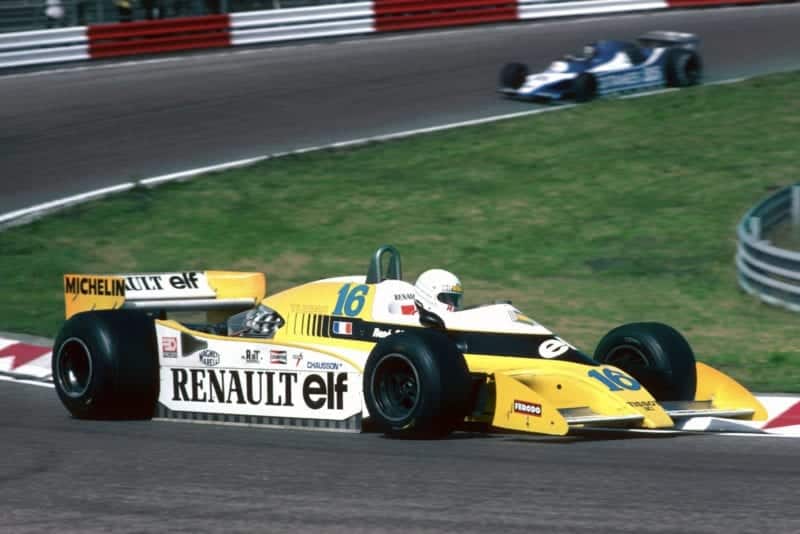
Arnoux crashed out on lap 1
Motorsport Images
Jabouille now began to lose contact with the leading pair as his clutch started to slip, through it seemed as though stale-mate had set in with Villeneuve leading Alan Jones, but unable to lose him. Equally Jones seemed unable to do anything about the Ferrari. Jarier disappeared out on the back of the circuit with the throttle slides on his Tyrrell jammed with sand, and when the inevitable happened to Jabouille’s clutch the scene was getting distinctly short of runners, with only 26 lap covered. As the Frenchman coaxed his ailing Renault back to the pits, Scheckter was all set to “jump” Rosberg and take fourth place, which he did as they went by the pits on full song, but with the demise of the Renault he automatically found himself in third place, and well deserved it was. Rosberg’s brave run came to an end when he went into the pits at the end of lap 32 with his engine misfiring. A new ignition unit was fitted and he went off again, but it was still misfiring and by the time he finished that lap the misfire had manifested itself in the form of a broken valve.
Half distance on a 75 laps race is half-way round lap 38, so we could only take stock at the end of that lap, and we found the Villeneuve/Jones situation unchanged, then a long way behind, but on the same lap, was Scheckter (Ferrari), then came Pironi all on his own, followed by Piquet (Brabham) and Laffite (Ligier) in close company, followed within sight by Mass (Arrows). The remaining three runners, Ickx (Ligier), Rebaque (Lotus) and de Angelis (Shadow) had all been lapped, so out of the twenty-four starters we had only ten left in the race. Both McLarens had gone out with engine trouble, and Stuck had given in to the vibrations before something serious broke.
As Rebaque came in to change a tyre on lap 43, it became increasingly obvious that the Williams was closer to the Ferrari than before and as Jones was still lapping regularly around the 1 min. 20 sec. mark it was clear that Villeneuve was in some sort of trouble and was slowing ever so slightly. As they started lap 47 the Williams was much too close for comfort and as they left the new “chicane” at something around 140 m.p.h. the Ferrari had its left rear wheel up on the kerb and was going into an enormous spin. With remarkable coolness Villeneuve stayed with the situation as the car spun across the track, and with equal coolness Alan Jones braked heavily as the Ferrari spun across the track in front of him, and as it gyrated onto the grass he opened out again and was away in the lead, with no drama, no dodging about, nothing spectacular. As the red car gyrated onto the grass on the inside of the track Villeneuve gathered it all up, having kept the engine running, and roared away after the fast disappearing Williams, as if nothing had happened. The cause of the spin, and the previous slowing down was a softening rear tyre, though it was not obvious until the Ferrari was up to maximum speed along the straight on lap 48 when the tyre overheated and burst just as the cars were passing the pits at around 170 m.p.h. Once again the remarkable Gilles Villeneuve was master of the situation, keeping the car straight and braking on three tyres while the burst one flapped around. He had no hope of stopping before the run-off area so at the last moment deliberately spun the car to a stop just off the track. There was no-one in sight behind him so he reversed off the track edge, across to the inside of the bend, and finding that the car was drivable he set off on lap 49 but the remains of the burst tyre damaged the rear suspension and by the time he got to the pits there was little left on that corner of the car, the remains of the wheel and the upright being dragged along the ground by the last remaining suspension link. It was all over.
All that Alan Jones had to do now was to cruise round and complete the 75 laps, but he was not without his problems for his gearbox was playing up, and it kept jumping out of gear, so he was not having an easy time. It was now lap 50 and Jones, Scheckter and Pironi were the only ones on the same lap, Laffite had got by Piquet to take fourth place but was lapped by the leader. Two laps later and Pironi was gone, skating to rest in the sand as a rear suspension upright broke, so we were down to seven survivors. Jones was 45 seconds ahead of Scheckter, so even with his gearbox problems he was in no danger and could afford to ease off slightly, his pit keeping well informed of the situation. This meant that Laffite began to catch up and as he was sitting too close behind for peace of mind, Jones let him go by, content to follow the Ligier rather than be followed. With Pironi gone Laffite was in third place, but a full lap down on the leader. Piquet was a strong fourth and it really began to look as though a V12 Alfa Romeo engine was going to last the distance. Ickx was fifth and Mass sixth, though the Arrows engine was beginning to sound rough and the German driver was dropping back though in no fear of losing his well-earned place. Rebaque was a lonely last after his pit-stop.
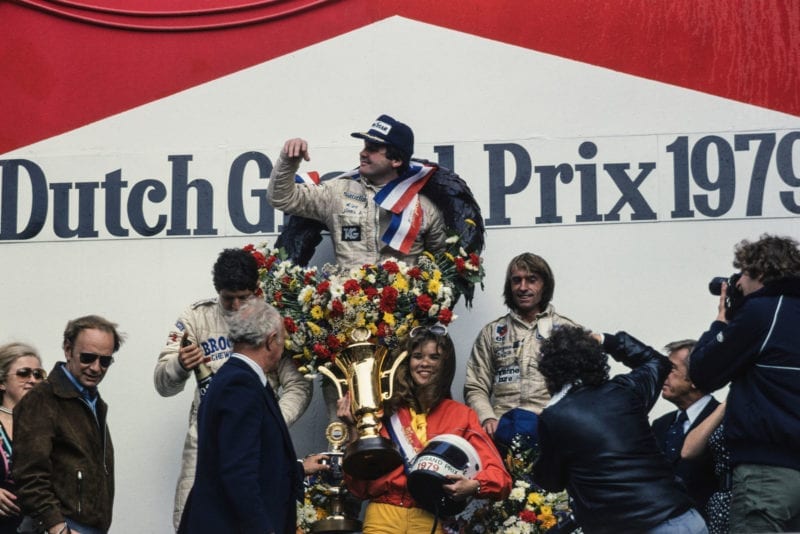
Jones celebrates his win
Motorsport Images
With over 20 seconds in hand Alan Jones scored his third victory on the trot, and it was the fourth win in succession for the Williams team. If ever we need an example of team-spirit reacting to their first win, the Frank Williams team is a classic example. They were strong at the British GP, which Regazzoni won for them, but then went from strength to strength, with Jones winning the German GP, and Austrian GP and now the Dutch GP and a huge part of the success is the fantastic spirit within the team, which is a very important part of motor racing. Full praise to Scheckter for his second place, won by determination and hard driving, for many drivers would have given up when they were 19th on the first lap, or burnt the clutch out completely when it started to slip. A rather muddled Jacques Laffite was lucky to finish third, but once again demonstrated his inborn tenacity, and it was nice to see Nelson Piquet arrive fourth, a place he should have had many times before. It was an interesting race and there was a lot to learn for those prepared to sit down and think about it afterwards. – D.S.J.
